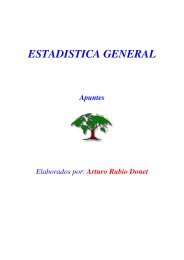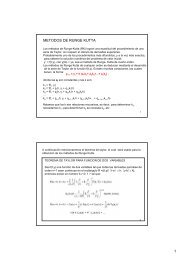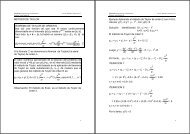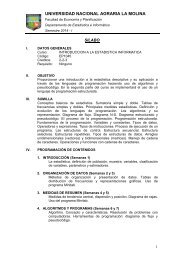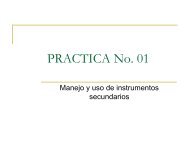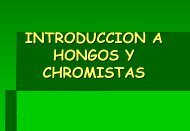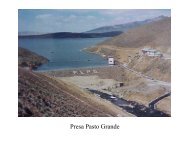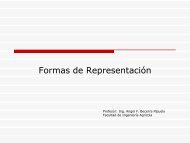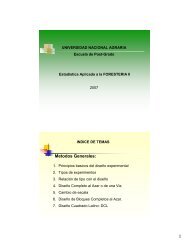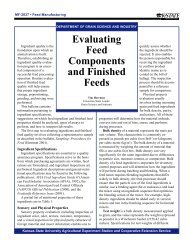In memoriam: Ernest John Christopher Polge (1926â2006)
In memoriam: Ernest John Christopher Polge (1926â2006)
In memoriam: Ernest John Christopher Polge (1926â2006)
- No tags were found...
Create successful ePaper yourself
Turn your PDF publications into a flip-book with our unique Google optimized e-Paper software.
Available online at www.sciencedirect.comTheriogenology 70 (2008) 1172–1173www.theriojournal.comObituary<strong>In</strong> <strong>memoriam</strong>: <strong>Ernest</strong> <strong>John</strong> <strong>Christopher</strong> <strong>Polge</strong> (1926–2006)Chris <strong>Polge</strong>, a founding member and activeparticipant of the <strong>In</strong>ternational Conference on BoarSemen Preservation, died on 17 August 2006 at the ageof 80 years and 1 day. <strong>Ernest</strong> <strong>John</strong> <strong>Christopher</strong> <strong>Polge</strong>was the son of a Buckinghamshire farmer, where he nodoubt developed his interest in the application of newdiscoveries to animal agriculture. He took an agriculturedegree from the University of Reading in 1946 and aPhD from the University of London in 1955. While adoctoral student at the National <strong>In</strong>stitute for MedicalResearch at Mill Hill, he solved a problem of longstanding interest—how to preserve living cells andtissues at cryogenic temperatures while preserving theirfunctionality. This discovery, in collaboration with hismentors, A.U. Smith and A.S. Parkes, is recorded in anarticle in Nature in 1949 [1]. This finding spawned thenew science of Cryobiology. Chris saw the importanceof the discovery for the cattle industry and soon turnedhis attention to bull sperm. This work, published in 1952[2], established frozen semen as an effective means ofproducing offspring in cattle. He was invited tonumerous bull studs and research institutes worldwideto demonstrate the new technology. These momentousscientific breakthroughs led to production practicesbuilt on freeze preservation of sperm and embryos thatform the basis for the livestock reproduction industry, aswe know it today.Dr. <strong>Polge</strong> recounted numerous times the story [3]behind the discovery that has been so instrumental to thedevelopment of cryopreservation in animal and medicalscience. As Chris would tell it, he was seeking to repeatthe observation on the effect of low temperature on fowlsperm that had been exposed to strong solutions ofsugars. He was focusing on fructose and had no success.After a several month hiatus and the relocation of hislaboratory to a field station, he resumed his experimentswith the old stock solutions and found that he could getsperm survival after freezing at 79 8C. Soon it cametime to make a fresh stock solution, and upon using it hefailed to obtain sperm survival. After several frustratingattempts to get survival with the new solution, he gavethe remaining ‘‘old’’ stock solution to a chemist whoafter some effort to identify it, passed it through a flameand recognized the characteristic smell of burningglycerol. An analysis showed that it contained a highlevel of glycerol, no reducing sugars, but a high level ofprotein. Based on that, he assumed that what hadhappened was that the labels on various bottles in therefrigerator had become ‘‘muddled up’’ so that the labelon the fructose stock had somehow been exchangedwith the one for a solution of glycerol and egg white(Meyer’s egg albumen), that was also being used in thelaboratory for histological work at that time. Chriswrote ‘‘it was the case of chance playing a big part inexperimentation [3].’’A review of research firsts from the <strong>Polge</strong> laboratoryat Mill Hill, and mostly at the Animal Research Station0093-691X/$ – see front matterdoi:10.1016/j.theriogenology.2008.06.089
Obituary / Theriogenology 70 (2008) 1172–1173 1173at Huntingdon Road, Cambridge is illustrative of his‘‘cutting edge’’ research accomplishments. It isimportant to recount those ‘‘firsts’’ of offspringproduced from frozen semen: chicks: 1949 [1] and1950 [4]; calves: 1952 [2]; and piglets: 1970 [5];and from embryos: calves: 1973 [6], lambs: 1976 [7],and mice: 1972 [8]. <strong>In</strong> addition to these firsts, there wasan abundance of other ‘‘cutting edge’’ research undertakenin his laboratory by students and visitingscientists. Significant advances were made in the areasof cloning, embryo splitting, twining, chimerism, invitro fertilization, synchronization of estrus, productionof transgenic animals, and AI of swine, to name only afew. Chris was fond of pointing out that the pig was hisfavorite animal. He began research with the pig early inthe 1950s and his report that he achieved a 60%conception rate in sows after AI in 1956 was abreakthrough of sorts for that time period [9].The <strong>Polge</strong> laboratory was clearly the premier placeto visit, or to come to, in order to conduct research onthe most important questions in animal physiology from1955 to 1985. A high number of these colleagues arewell known leaders in reproductive science around theworld. Chris led the Animal Research Station for 8years prior to the closing of the Huntingdon Roadlocation in 1986. He then co-founded Animal BiotechnologyCambridge Ltd., a start-up company wherehe continued to pursue his research interests, consistentwith his philosophy of translating research advancesinto commercial application. An example was to usesexed semen for IVF to produce embryos that were thenfrozen and thawed and transferred to beef cows onfarms to produce the first calves (90% of the desiredsex) from embryos fertilized with sexed semen [10].Chris <strong>Polge</strong>, whose accomplishments spanned morethan 50 years, became a world authority in animalreproductive science with few peers. Yet, he remained amodest and unassuming man. He was the recipient ofmany significant awards and honors, among them theprestigious 8th Japan Prize for Science & Technology,The Wolf Foundation Prize in Agriculture (Israel);Elected – Fellow, Royal Society and – ForeignAssociate, U.S. National Academy of Science; Commanderof the British Empire, CBE; Pioneer Award,<strong>In</strong>ternational Embryo Transfer Society; The FirstBertebos Prize, Sweden; and Honorary doctorates fromthe University of Illinois and from the University ofGuelph. He was active in various national and worldscience organizations established for the advancementof science, especially in reproduction.Chris’s infectious enthusiasm for scientific discovery,and his inquisitive intellect, infected all who knewhim. Everyone who heard him speak, teach, instruct, orparticipate in scientific meetings learned and benefitedfrom this man who was as comfortable and pleasanttalking to the movers and shakers of the world, as he wastalking to the newest graduate student. Many of hiscolleagues from around the world have experienced thegracious hospitality of Chris and his wife Olive, wherehomemade soups and breads were a Chris <strong>Polge</strong>specialty. Chris is survived by his wife, Olive of 52years and four children, all of whom chose sciencecareers (a dentist, a medical doctor, a physiotherapist,and a PhD in plant science) and nine grand children.Chris was a warm and trusted friend to all who knewhim and is greatly missed.References[1] <strong>Polge</strong> C, Smith AU, Parkes AS. Revival of spermatozoa aftervitrification and dehydration at low temperatures. Nature1949;164:666.[2] <strong>Polge</strong> C, Rowson LEA. Results with bull semen stored at79 8C. Vet Rec 1952;851.[3] <strong>Polge</strong> C. Sperm freezing: past, present and future. <strong>In</strong>: <strong>John</strong>sonLA, Larsson K, editors. Deep Freezing of Boar Semen. Uppsala:Swedish University of Agricultural Sciences; 1985. pp. 167–73.[4] <strong>Polge</strong> C. Functional survival of fowl spermatozoa after freezingat 798 C. Nature 1950;167:949–50.[5] <strong>Polge</strong> C, Salamon S, Wilmut I. Fertilizing capacity of frozenboar semen following surgical insemination. Vet Rec1970;87:424–8.[6] Wilmut I, Rowson LEA. Experiments on the low temperaturepreservation of cow embryos. Vet Rec 1973;92:686–90.[7] Willadsen SM, <strong>Polge</strong> C, Rowson LEA, Moor RM. Deep freezingof sheep embryos. J Reprod 1976;46:151–4.[8] Wilmut I, <strong>Polge</strong> C. Effect of cooling rate, warming rate, protectiveagent and stage of development on survival of mouseembryos during freezing and thawing. Life Sci 1972;11:1071–9.[9] <strong>Polge</strong> C. Artificial insemination in pigs. Vet Rec 1956;68:62–76.[10] Cran DG, <strong>John</strong>son LA, <strong>Polge</strong> C. Sex preselection in cattle: a fieldtrial. Vet Rec 1995;135:495–6.Lawrence A. <strong>John</strong>son16920 Hardy Road, Mount Airy, MD 21771, USAE-mail address: lajohnson@verizon.net



